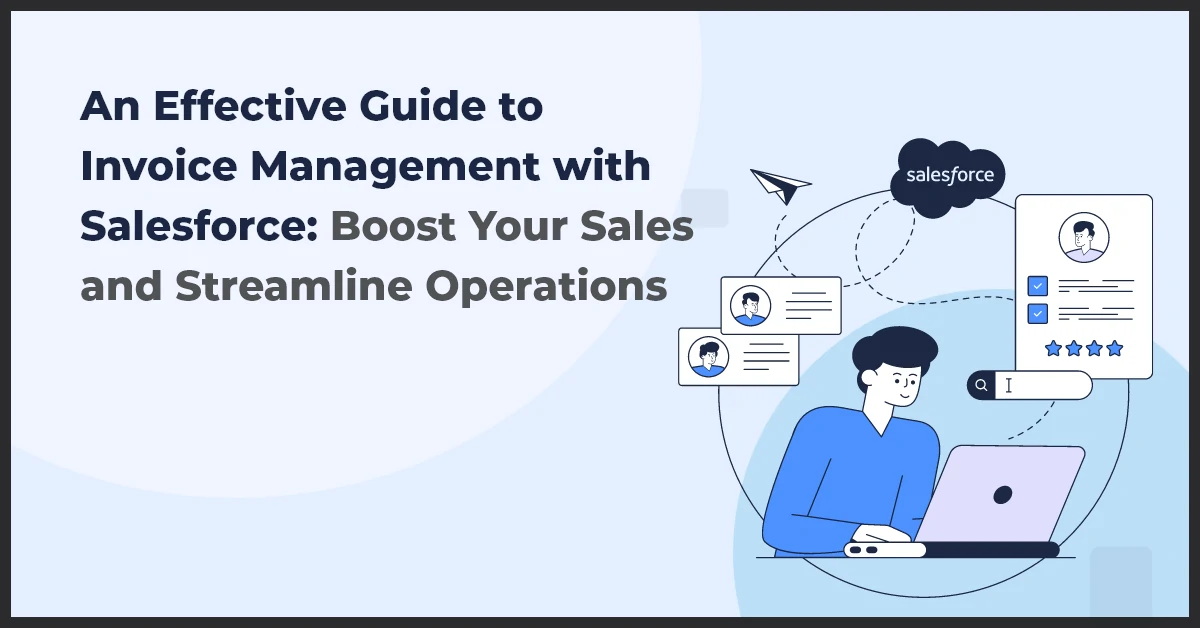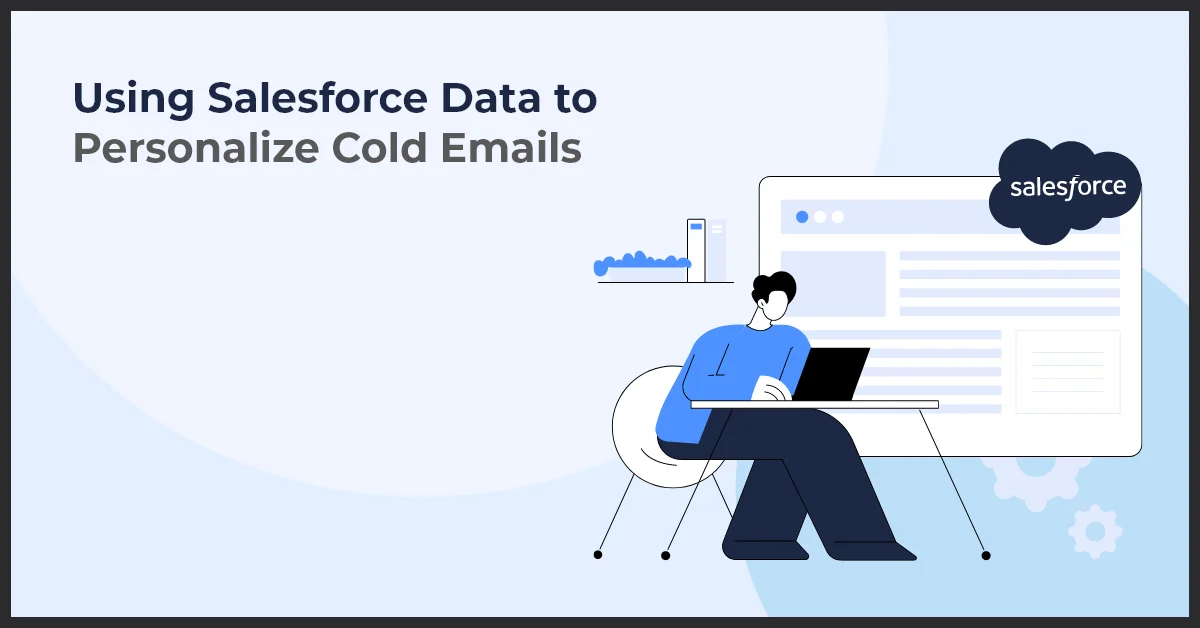An Effective Guide to Invoice Management with Salesforce: Boost Your Sales and Streamline Operations

Published on: December 1, 2023
Updated on: July 19, 2024
783 Views
- Salesforce
14 min read
Invoice management is a critical aspect of any business, whether small or large. The ability to efficiently create, track, and manage invoices not only ensures timely payments but also enhances overall financial organization and customer satisfaction. With Salesforce as your CRM platform, you can take your invoice management to new heights.
In this comprehensive content plan, we will guide you through the various features and functionalities Salesforce offers for managing invoices. You will learn how to streamline your invoicing process, improve accuracy, and increase your sales revenue. From generating customized invoices to automating payment reminders, we cover it all.
Invoice Basics
An invoice is a document that serves as a request for payment for goods or services provided. It is an essential part of any business transaction as it provides a record of the transaction and ensures timely payment.
There are several key components of an invoice that are important to include:
- Invoice Number: Each invoice should have a unique identification number for tracking purposes.
- Due Date: The due date specifies the deadline for payment.
- Itemized Charges: An itemized list of charges outlines the details of the goods or services provided and their costs.
There are different types of invoices that businesses may use:
- Recurring Invoices: These are invoices that are generated and sent on a regular basis, such as monthly or annually, for ongoing services.
- Proforma Invoices: Proforma invoices are issued before the actual goods or services are delivered, providing a preview of the expected charges.
When it comes to managing invoices, Salesforce offers numerous benefits:
- Efficiency: Salesforce allows for streamlined invoice creation, tracking, and management, reducing manual effort and potential errors.
- Automation: With Salesforce, you can automate invoice generation, reminders, and notifications, ensuring timely payments.
- Integration: Salesforce seamlessly integrates with finance systems, enabling smooth data flow and eliminating the need for manual data entry.
- Payment Processing: Salesforce provides secure payment processing capabilities, allowing customers to easily make payments directly within the platform.
- Reporting and Analytics: Salesforce offers robust reporting and analytics features, providing insights into invoice performance, payment trends, and more.
- Customization: You can customize your invoices in Salesforce to align with your brand identity and incorporate personalized messaging.
- Apps and Add-ons: Salesforce offers a wide range of apps and add-ons that enhance invoicing capabilities, such as invoice templates and automated late payment fees.
- Self-Service: Salesforce communities allow for self-service invoice access, empowering customers to view, download, and make payments on their own.
- Compliance and Security: Salesforce ensures compliance with data protection regulations and offers robust security measures to safeguard sensitive invoice information.
Salesforce CRM for Invoicing
Salesforce CRM offers a comprehensive solution for managing and organizing invoices within your business. With its powerful capabilities, you can streamline and automate the invoicing process to improve efficiency and accuracy.
Overview of Salesforce's CRM capabilities related to invoicing
Salesforce CRM provides a centralized platform for all your invoicing needs. It allows you to create, track, and manage invoices with ease. From generating invoices to monitoring payment statuses, Salesforce CRM offers a seamless invoicing experience.
Features and functionalities of Salesforce CRM for managing invoices
With Salesforce CRM, you can customize invoice templates to reflect your brand identity. You can also automate invoice generation and delivery, saving you time and effort. Moreover, Salesforce CRM enables you to set up automated reminders for overdue invoices, ensuring prompt payment from your customers.
Additionally, Salesforce CRM provides a range of tools for managing customer information, such as contact details, payment history, and communication logs. This allows you to have a holistic view of your customers and their invoicing requirements.
Integration of invoicing processes within Salesforce's CRM platform
Salesforce CRM seamlessly integrates with other finance systems, allowing for smooth data flow and eliminating the need for manual data entry. This integration ensures that your invoicing processes are streamlined and error-free.
By integrating invoicing processes within Salesforce CRM, you can easily access invoicing information alongside customer data, providing a comprehensive view of your business relationships and financial transactions.
With Salesforce CRM, you can take your invoicing process to the next level. Leverage its capabilities to automate and streamline your invoicing operations, improving efficiency and reducing manual errors.
Salesforce Invoice Automation
Are you tired of spending countless hours manually generating invoices for your business? Look no further than Salesforce's powerful automation tools to streamline your invoicing process. With Salesforce Invoice Automation, you can explore various ways to automate the invoice generation process and enjoy the benefits of increased efficiency and reduced manual effort.
- Efficiency: By automating your invoice generation, you can say goodbye to the days of manual data entry and repetitive tasks. Salesforce's automation tools allow you to create templates and set up rules that automatically generate invoices based on your predefined criteria.
- Reduced Manual Effort: With Salesforce Invoice Automation, the days of manually creating and sending invoices are over. You can save time and resources by letting Salesforce do the work for you, giving you more time to focus on other important aspects of your business.
Setting up automated invoice generation in Salesforce is a breeze. Follow this step-by-step guide to get started:
- Access your Salesforce CRM and navigate to the "Setup" page.
- Under "App Setup," select "Automation" and then click on "Process Builder."
- Create a new process and define the criteria for automated invoice generation. This can include factors such as specific products or services, customer information, or payment terms.
- Once the criteria are set, specify the actions that need to be taken for invoice generation. This can include generating a PDF invoice, attaching it to an email, and sending it to the customer.
- Save and activate the process to begin automated invoice generation.
With Salesforce's powerful automation capabilities, you can take your invoicing process to the next level. Say goodbye to manual effort and hello to increased efficiency with Salesforce Invoice Automation.
Payment Processing in Salesforce
When it comes to payment processing, Salesforce provides a range of options to ensure smooth and efficient transactions within your invoicing process. With these features, you can easily integrate with payment gateways, track payment status, and enhance the overall customer experience.
Overview of payment processing options available within Salesforce
Salesforce offers various payment processing options to suit your business needs. Whether you prefer manual processing or automation, you can find the right solution within the platform.
Integrating with payment gateways for efficient payment collection
With Salesforce, you can seamlessly integrate with popular payment gateways, allowing you to collect payments efficiently and securely. By integrating these gateways, you provide your customers with a convenient and reliable payment experience.
Tracking payment status within Salesforce and enhancing customer experience
Salesforce enables you to easily track the status of payments directly within the platform. This feature allows you to stay on top of pending payments, avoid delays, and provide excellent customer service. By having real-time visibility into payment status, you can enhance the overall customer experience and build trust with your clients.
With Salesforce's payment processing capabilities, you can streamline your invoicing process, improve cash flow, and ensure a positive customer experience.
Reporting and Analytics for Invoicing
When it comes to invoicing, generating accurate and insightful reports is crucial for businesses. With Salesforce's robust reporting and analytics features, you can streamline your invoicing process and gain valuable insights into your sales and revenue. Here's how:
Exploring Salesforce's reporting and analytics features for generating invoice reports
Salesforce offers a wide range of reporting tools that enable you to create custom reports specifically tailored to your invoicing needs. You can easily track and assess key metrics such as total invoices generated, payment status, outstanding invoices, and more.
Analyzing invoice data to gain insights into sales and revenue
By leveraging Salesforce's analytics capabilities, you can delve deeper into your invoice data to identify trends, spot patterns, and uncover opportunities for optimizing your invoicing strategy. Analyze invoice data by customer, product, region, or any other relevant dimension to gain actionable insights.
Steps to leverage Salesforce's analytics features for improved invoicing strategies
To make the most of Salesforce's reporting and analytics features for your invoicing process, follow these steps:
- Define your reporting goals and identify the key metrics that matter most to your invoicing strategy.
- Create custom reports and dashboards to monitor invoice performance and track progress towards your goals.
- Use filters and groupings to analyze invoice data from different perspectives and dimensions.
- Utilize advanced analytics tools, such as forecasting and predictive analytics, to make data-driven decisions and optimize your invoicing strategy.
With Salesforce's reporting and analytics capabilities, you can elevate your invoicing process, gain deeper insights into your sales and revenue, and drive better business outcomes.
Customization and Personalization of Invoices
Customizing invoice templates in Salesforce to align with brand identity
- With Salesforce CRM, you have the ability to customize your invoice templates to match your brand's unique identity.
- By incorporating your brand's colors, logos, and fonts, you can ensure that your invoices reflect your company's professionalism and attention to detail.
- With a cohesive and consistent look across all your invoicing materials, you can reinforce your brand and leave a lasting impression on your customers.
Adding personalized branding elements to invoices for better customer experience
- Personalization is key when it comes to creating a memorable customer experience.
- With Salesforce CRM, you can easily add personalized branding elements to your invoices, such as personalized messages or customer-specific information.
- By tailoring your invoices to your customers' needs and preferences, you can enhance the overall customer experience and strengthen your customer relationships.
Configuring invoice workflows based on specific business requirements
- Every business has unique invoicing requirements.
- Salesforce CRM allows you to configure invoice workflows to align with your specific business needs.
- From automating approval processes to setting up reminders for overdue payments, you have the flexibility to design invoice workflows that streamline your invoicing operations and improve your cash flow.
Salesforce Apps and Add-ons for Invoicing
When it comes to invoicing, Salesforce offers a dynamic ecosystem of third-party applications and add-ons that can enhance your invoicing process and provide additional features to streamline your workflow. By leveraging Salesforce's marketplace, you can find suitable apps and add-ons to manage your invoices more efficiently.
- One popular app is InvoiceIT, which integrates seamlessly with Salesforce CRM and automates the creation and sending of invoices. With this app, you can save valuable time and eliminate manual data entry.
- Another handy add-on is EasyPayment, which enables you to process payments directly within Salesforce. This integration ensures a seamless and secure payment process for your customers.
- If you need advanced reporting and analytics capabilities for your invoicing, an app like InvoiceAnalytics can provide valuable insights into your billing performance. It allows you to track key metrics and identify areas for improvement.
These are just a few examples of the many apps and add-ons available within the Salesforce ecosystem. Whether you need to automate your invoicing, integrate with external finance systems, or customize your invoices with personalized branding, there's likely an app or add-on that fits your needs.
By exploring Salesforce's marketplace, you can discover a wide range of options to enhance your invoicing process and streamline your operations. Take advantage of the diverse ecosystem to find the right tools to optimize your invoice management.
Salesforce Communities for Invoice Self-Service
Are you looking for a way to provide your customers with a seamless self-service experience when it comes to their invoices? Look no further than Salesforce Communities. With Salesforce Communities, you can leverage the power of your Salesforce platform to create customizable and personalized invoice self-service portals for your customers.
Leveraging Salesforce Communities to provide self-service invoice portals for customers
Salesforce Communities allows you to create a secure and customized portal where your customers can access and manage their invoices with ease. By providing a self-service option, you empower your customers and free up your customer support team to focus on more complex issues.
Benefits of self-service invoice portals in terms of customer satisfaction and efficiency
Implementing self-service invoice portals through Salesforce Communities offers several benefits. Firstly, it greatly improves customer satisfaction by giving them the freedom to access their invoices at any time, from any device. Secondly, it enhances efficiency by reducing the volume of customer inquiries related to invoices, saving your team valuable time and resources.
Step-by-step guide for setting up invoice self-service portals in Salesforce Communities
- Start by enabling Salesforce Communities in your Salesforce org.
- Design the layout and branding of your invoice self-service portal to ensure a seamless customer experience.
- Create a custom community for your invoice self-service portal.
- Set up secure user authentication and access controls to protect customer data.
- Configure the necessary permissions and sharing settings to allow customers to view and manage their invoices.
- Integrate your invoice data with Salesforce Communities to ensure real-time updates and accurate information.
- Create an intuitive navigation structure that allows customers to easily find and access their invoices.
- Add self-service features such as invoice search, download, and payment options to enhance the customer experience.
- Test the functionality and usability of your invoice self-service portal before rolling it out to customers.
- Monitor and analyze customer interactions to identify areas for improvement and optimize the self-service experience.
Compliance and Security in Invoicing
When it comes to invoicing, compliance and security are of utmost importance. With Salesforce, you can ensure that your invoicing processes meet all the necessary regulations while keeping your customer and financial data secure.
Ensuring compliance with invoicing regulations within Salesforce
Salesforce provides a range of features and tools to help you stay compliant with invoicing regulations. You can customize and configure your invoice templates to include all the required information, such as tax details, invoice numbers, and legal disclaimers. Additionally, Salesforce allows you to automate tasks and workflows, ensuring that all invoicing processes follow the necessary regulations.
Incorporating robust security measures to protect customer and financial data
Protecting your customer and financial data is crucial in today's digital landscape. Salesforce offers advanced security features to safeguard your invoicing data. With built-in encryption, multi-factor authentication, and role-based access controls, you can control who has access to your invoicing information. Furthermore, Salesforce regularly undergoes security audits and compliance certifications to maintain the highest level of data protection.
Best practices for maintaining compliance and security standards in Salesforce
To maintain compliance and security standards in Salesforce invoicing, follow these best practices:
- Regularly review and update your invoicing processes to align with changing regulations.
- Establish strong password policies and encourage employees to use unique, complex passwords.
- Implement data encryption for sensitive invoicing data.
- Train your staff on security awareness and best practices to protect against phishing and other cyber threats.
- Regularly monitor and audit user access and activity to detect any unauthorized actions.
By following these best practices, you can maintain a compliant and secure invoicing environment within Salesforce.
Conclusion
Throughout this content plan, we have explored the various aspects of Salesforce invoicing and how it can benefit your business. Let's recap the main points covered:
- Invoice Basics: Understanding the fundamentals of invoicing.
- Salesforce CRM for Invoicing: Leveraging Salesforce CRM to streamline your invoicing process.
- Salesforce Invoice Automation: Automating your invoice generation and delivery with Salesforce.
- Payment Processing in Salesforce: Simplifying payment processing within Salesforce.
- Reporting and Analytics for Invoicing: Gaining valuable insights through reporting and analytics.
- Customization and Personalization of Invoices: Tailoring invoices to meet your branding and customer needs.
- Salesforce Apps and Add-ons for Invoicing: Exploring additional apps and add-ons for enhanced invoicing capabilities.
- Salesforce Communities for Invoice Self-Service: Empowering customers with self-service invoice capabilities.
- Compliance and Security in Invoicing: Ensuring compliance and security measures for your invoices.
Now that you have a comprehensive understanding of Salesforce invoicing, it's time to leverage this powerful platform for effective invoice management. By implementing Salesforce, you can streamline your invoicing process, increase efficiency, and enhance customer satisfaction.
Interested in learning more or getting started with Salesforce invoicing? Subscribe to our newsletter for the latest updates and tips, or contact our team for further assistance. Take advantage of Salesforce's capabilities and revolutionize your invoice management today!
Frequently Asked Questions
Invoice management in Salesforce involves using Salesforce tools and integrations to create, track, and manage invoices efficiently within the CRM platform.
Benefits include improved accuracy of invoicing data, enhanced visibility into customer billing history, automation of invoice generation, and seamless collaboration between sales and finance teams.
Salesforce supports invoice management through features like Salesforce Billing, which automates invoicing processes, tracks payment statuses, manages billing schedules, and integrates with CRM data for streamlined financial operations.
Salesforce automates invoice generation through Salesforce Billing. It uses templates, integrates with CRM data, and schedules invoicing based on triggers such as contract milestones or recurring billing cycles, ensuring accuracy and efficiency in billing processes.
By integrating with CRM data and automating invoice generation, Salesforce reduces errors associated with manual data entry and ensures invoices reflect up-to-date customer information.



